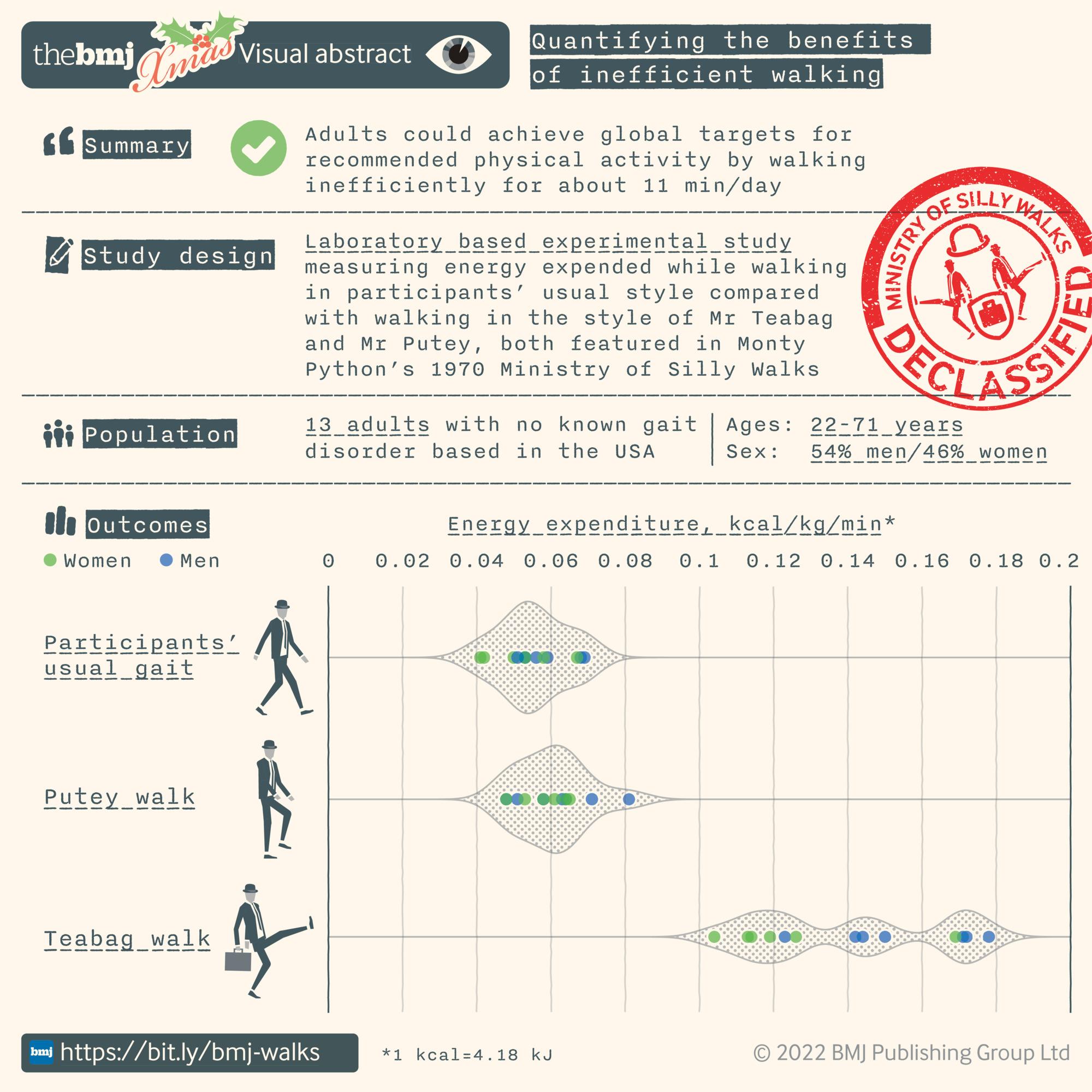博文
每天“蒂巴格式”走几分钟对公共健康有重要好处
||
每天“蒂巴格式”走几分钟对公共健康有重要好处
诸平

据《英国医学杂志》(BMJ )2023年2月2日提供的消息,新研究:每天“蒂巴格式”走几分钟对公共健康有重要好处(New Study: Walking “Teabag Style” for a Few Minutes a Day Could Have Important Public Health Benefits)。
蒂巴格式行走(Teabag walking)是一种锻炼方式,涉及以缓慢的小步走。它被认为会增加身体活动的低效率,使其成为传统运动形式的替代品。这种步行方式的灵感来自喜剧团体巨蟒剧团(Monty Python),作为一种促进公众健康的方式而广受欢迎。
一项受巨蟒剧团影响的研究声称,降低身体活动的效率可能对公共健康有重大好处。2022年12月21日发表在《英国医学杂志》网站上的一项研究表明,成年人只需每天以低效率的方式步行几分钟即可达到全球体育锻炼目标。详见Glenn A Gaesser, David C Poole, Siddhartha S Angadi. Quantifying the benefits of inefficient walking: Monty Python inspired laboratory based experimental study. BMJ, 2022, 379: e072833. DOI: 10.1136/bmj-2022-072833. Published 21 December 2022. https://www.bmj.com/content/379/bmj-2022-072833
参与此项研究的有来自美国亚利桑那州凤凰城亚利桑那州立大学健康解决方案学院(College of Health Solutions, Arizona State University, Phoenix, AZ, USA)、美国曼哈顿的堪萨斯州立大学(Kansas State University, Manhattan, KS, USA)以及美国弗吉尼亚大学(University of Virginia, Charlottesville, VA, USA)的研究人员。
尽管人们努力增加成年人的身体活动并改善心血管健康,但全球缺乏身体活动的比例在过去 20年中一直保持不变。
1971年巨蟒剧团傻步行走(1971 Monty Python Ministry of Silly Walks)草图中由约翰·克里斯(John Cleese)和迈克尔·佩林(Michael Palin)扮演的蒂巴格先生(Mr. Teabag)和普蒂先生(Mr. Putey)效率低下的步行方式已被证明比平时的步行方式更具可变性,但它们的能量消耗从未被测量过。
为了填补这一重要的研究空白,一组美国研究人员着手比较低效率步行和高效步行的能量消耗。他们的发现基于13名年龄在22-71岁(平均年龄34岁)之间的健康成年人(6名女性,7名男性)的数据,他们没有心脏病或肺病史,也没有已知的步态障碍(gait disorder)。
测量了身高和体重,并向每位参与者展示了傻步行走草图的视频,然后围绕室内30米跑道进行了三项步行试验,每次持续5分钟。
在第一次试验中,参与者以他们通常的方式以自由选择的速度行走。在接下来的两次试验中,参与者被要求尽最大努力重现他们在视频中看到的蒂巴格先生和普蒂先生的步行。
5分钟步行的距离被用来计算平均速度。还测量了摄氧量 (mL/kg/min)、能量消耗 (kcal/kg/min) 和运动强度 (exercise intensity,METs)——每分钟体力活动消耗的卡路里量。
研究人员发现,只有蒂巴格式步行导致能量消耗显著增加——大约是普通步行的2.5倍。对于男性和女性,正常步行期间的摄氧量为11.3 mL/kg/min(或 3.2 METs),这与普蒂式步行(12.3 mL/kg/min,或3.5 METs)相似。然而,蒂巴格式步行引起的摄氧量为27.9 mL/kg/min,或 8 METs,符合高强度运动的条件。
在能量消耗方面,将一分钟的常规步行方式换成一分钟的蒂巴格式步行,使男性的能量消耗增加8 kcal/min,使女性的能量消耗增加5 kcal/min。
研究人员估计,通过以蒂巴格式行走(而不是他们通常的行走方式)大约每天11分钟,成年人每周就可以进行75分钟的高强度体育锻炼。并且用蒂巴格式步骤代替通常的步骤大约 12-19 分钟/天会增加大约100 卡路里(100 kcal)的每日能量消耗。
他们补充说,如此大量的蒂巴格式步行可能会增加心肺健康,降低死亡风险,并且不需要额外的时间承诺,因为它取代了成年人已经用更高能量的体育活动进行的运动。
这是一项基于小样本的实验研究,研究人员承认,一些人,包括那些有残疾、步态障碍、关节疾病或其他健康问题的人可能无法进行普蒂式步行或蒂巴格式步行。“但他们可能会以其他方式增加日常运动中的能量消耗,以低效率为目标,”他们说。
他们还指出,随着时间的推移,短至一到两分钟的突发性体育锻炼可以产生心血管益处,因此人们可以在对他们来说最方便的时间和地点(包括室内)进行规律性的突发性低效步行。
他们写道:“我们对不同步行方式消耗的能量的分析旨在让人们能够以更有活力——希望更快乐的方式——来移动自己的身体。促进心血管健康的努力应该包括所有人的包容性和低效率。”
上述介绍,仅供参考。欲了解更多信息,敬请注意浏览原文或者相关报道。
Objective To compare the rate of energy expenditure of low efficiency walking with high efficiency walking.
Design Laboratory based experimental study.
Setting United States.
Participants 13 healthy adults (six women, seven men) with no known gait disorder, mean (±standard deviation) age 34.2±16.1 years, height 174.2±12.6 cm, weight 78.2±22.5 kg, and body mass index 25.6±6.0.
Intervention Participants performed three, five minute walking trials around an indoor 30 m course. The first trial consisted of walking at a freely chosen walking speed in the participant’s usual style. The next two trials consisted of low efficiency walks in which participants were asked to duplicate the walks of Mr Teabag and Mr Putey (acted by John Cleese and Michael Palin, respectively) in the legendary Monty Python Ministry of Silly Walks (MoSW) skit that first aired in 1970. Distance covered during the five minute walks was used to calculate average speed. Ventilation and gas exchange were collected throughout to determine oxygen uptake (V̇O2; mL O2/kg/min) and energy expenditure (EE; kcal/kg/min; 1 kcal=4.18 kJ), reported as mean±standard deviation.
Main outcome measures V̇O2 and EE.
Results V̇O2 and EE were about 2.5 times higher (P<0.001) during the Teabag walk compared with participants’ usual walk (27.9±4.8 v 11.3±1.9 mL O2/kg/min; 0.14±0.03 v 0.06±0.01 kcal/kg/min), but were not different during the Putey walk (12.3±1.8 mL/kg/min; 0.06±0.01 kcal/kg/min). Each minute of Teabag walking increased EE over participants’ usual walking by an average of 8.0 kcal (range 5.5-12.0) in men and by 5.2 kcal (range 3.9-6.2) in women, and qualified as vigorous intensity physical activity (>6 resting metabolic equivalents).
Conclusions For adults with no known gait disorder who average approximately 5000 steps/day, exchanging about 22%-34% of their daily steps with higher energy, low efficiency walking in Teabag style—requiring around 12-19 min—could increase daily EE by 100 kcal. Adults could achieve 75 minutes of vigorous intensity physical activity per week by walking inefficiently for about 11 min/day. Had an initiative to promote inefficient movement been adopted in the early 1970s, we might now be living among a healthier society. Efforts to promote higher energy—and perhaps more joyful—walking should ensure inclusivity and inefficiency for all.
https://blog.sciencenet.cn/blog-212210-1374973.html
上一篇:让药物适应DNA可使副作用减少30%
下一篇:500年未解,研究人员破解了达芬奇悖论
